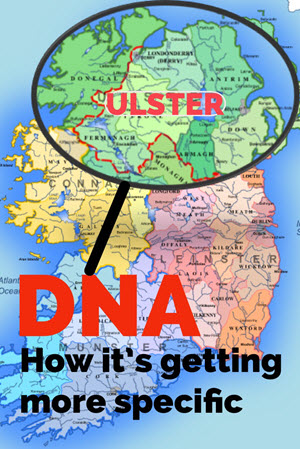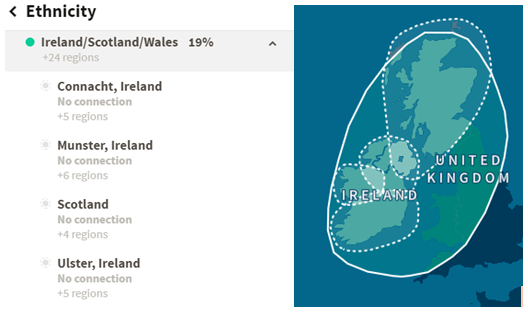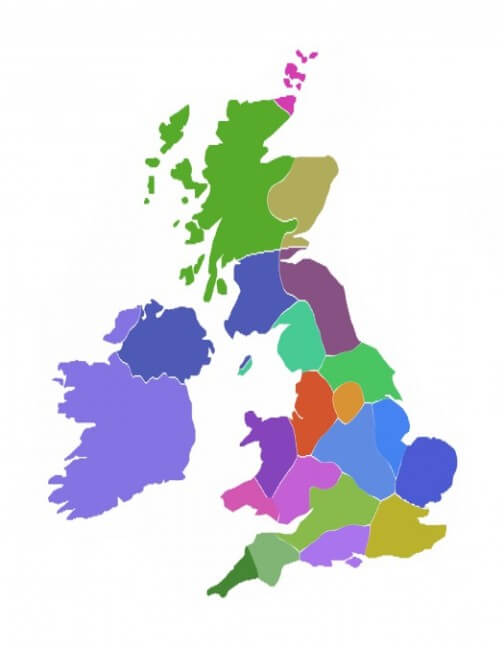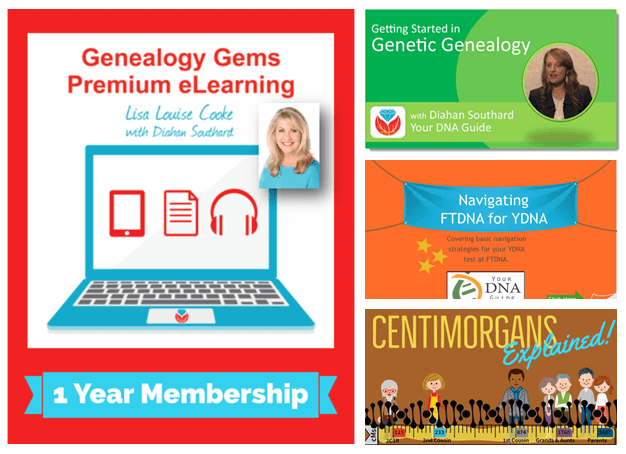When it comes to the accuracy of DNA ethnicity results, there’s some good news: they’re getting more specific. Your initial results that said “Irish” may now point specifically to Ulster. Here, Your DNA Guide Diahan Southard talks about this promising progress.
One of the questions I get asked most often is to predict the future of genetic genealogy. While I don’t have a crystal ball, I am certain that the future of genetic genealogy holds two things: automation and specificity. We will save the automation discussion for another day (it was hinted at in RootsTech announcements by both MyHeritage and Living DNA) and focus here on the exciting topic of specificity.
DNA ethnicity accuracy: Specificity on the rise
Since the launch of the autosomal DNA test, we have seen an incredible increase in the specificity of our origins reports. In 2007, 23andMe was breaking down your heritage into three main categories: Europe, Asia, and Africa. Now, 11 years later, after several revisions, they have released a new update expanding their origins product from 31 categories to 150! That’s an increase in specificity of 4,900%!!!! All companies are moving in this same direction, with AncestryDNA releasing a small update in April of 2018, to try to provide more detail to the story of your ancestral heritage.
This trend toward increasing specificity also appears in reports from academia. For example, in December of 2017, there was a study released by the Royal College of Surgeons in Ireland working with the Genealogical Society of Ireland. The study details a component that is especially important to genealogists: time. While it might be interesting to know that you had an ancestor who once walked the moors, it would be even more valuable to know when he was there.
In this study, they can see both the current genetic clusters in Ireland (they report 10) but also measure how genetically similar those clusters are to other places. That means we can not only tell you where you are from in Ireland, but also where you were before that. It’s a bit like the sticker you see on the fruit at the grocery store. Right now it is in your store, but the sticker tells you where it was before that.
AncestryDNA origins reports
This same kind of research is reflected in AncestryDNA’s Migrations, which are a feature of their origins report. Migration communities, like Lower Midwest Settlers, identify your ancestral locations hundreds of years ago, as opposed to the Regions, like Europe West, which identify your ancestral locations thousands of years ago.
Sticking with the Irish theme, we see that AncestryDNA places Ireland in a region with Scotland and Wales. This large region is then broken up into four subregions, each with its own subregions, for a total of 24 different Irish categories. (You can view this image by clicking on See all 150+ regions at the bottom of the ethnicity window.)
Much like the study from academia in Ireland, we can track these Irish groups through time using the tools at AncestryDNA. Essentially, if you find yourself in any of the subregions, then you know that your connection to that particular place was likely within a genealogical timeframe (the last 300 years). What if you do not yet find yourself in a subgroup, but as shown in the example here, you see simply no connection to these subregions? It either means your connection to Ireland is farther back than 300ish years, or that the subregion you are from has not yet been defined.
Living DNA ethnicity categories in UK
Currently Living DNA has the most specificity in the UK as they can distinguish between 42 regions in England, Wales, Ireland and Scotland (map shown here). Living DNA has announced similar regional projects in other countries, including Germany.
But even with this specificity, it can still be tricky to make genealogical connections between your maps and your family tree. In the coming months and years, even that will change. As the databases get bigger, it will be the connections between people who are tested that will add to the layer of genealogy specificity that we are missing. In other words, it will be less about whether you have a specific piece of DNA tagging you as from Cork, Ireland, and more about the fact that your DNA connects to you to an entire group of people who have documented ancestors from Cork. This may seem like a small distinction, but it makes all the difference, and is the driving principle behind AncestryDNA’s Migrations tool, and what Living DNA is hinting at as well.
So, what will the future hold? Nobody has all the answers, and that is part of the fun of it. But one thing I am certain of: the future does hold more specific answers to our genetic genealogy questions.
Did you hear?
We have added 21 of Diahan Southard’s DNA tutorial videos to our Premium Membership, which is now Premium eLearning! DNA is a gateway to genealogical discoveries, so it pays to know all you can about using DNA in your family history research plan. We’ve organized Diahan’s comprehensive DNA tutorial series into four categories: General DNA (including beginner), Autosomal DNA, Mitochondrial DNA, and YDNA. Watch all of them or start with what you most want to learn now. And remember, as fantastic as this DNA series is, it’s only one of the many Premium video topics you’ll have exclusive access to with your Premium eLearning. Click here to learn more.

The Author: Diahan Southard
Your DNA Guide
Diahan is Your DNA Guide at Genealogy Gems! She has worked with the Sorenson Molecular Genealogy Foundation, and has been in the genetic genealogy industry since it has been an industry. She holds a degree in Microbiology and her creative side helps her break the science up into delicious bite-sized pieces for you. She’s the author of a full series of DNA guides for genealogists.
Disclosure: This article contains affiliate links and Genealogy Gems will be compensated if you make a purchase after clicking on these links (at no additional cost to you). Thank you for supporting Genealogy Gems!








